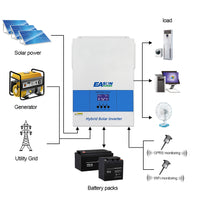In the ever-evolving world of solar energy, solar charge controllers play a pivotal role in ensuring the efficiency and longevity of photovoltaic systems. This ultimate guide to solar charge controller features aims to provide a comprehensive understanding of the two primary technologies: MPPT (Maximum Power Point Tracking) and PWM (Pulse Width Modulation).

What is a Solar Charge Controller?
A solar charge controller is an essential component in a solar power system. It regulates the voltage and current coming from the solar panels to the battery. Without it, batteries could be overcharged or discharged, leading to reduced lifespan and efficiency.
MPPT Technology
MPPT stands for Maximum Power Point Tracking. This technology is designed to extract the maximum possible power from the solar panels by adjusting the electrical operating point of the modules. How does it work? By continuously monitoring the voltage and current output of the solar panels, MPPT controllers can determine the optimal power point and adjust accordingly.
MPPT controllers are known for their efficiency, often achieving 95-98% efficiency in converting solar energy to usable power.
One of the key benefits of MPPT technology is its ability to handle varying weather conditions, ensuring consistent power output. For instance, the MPPT Controller 12345 from our JSON data showcases this capability with its advanced tracking algorithms.
PWM Technology
PWM, or Pulse Width Modulation, is another widely used technology in solar charge controllers. Unlike MPPT, PWM controllers maintain a constant voltage output by rapidly switching the power on and off. This method is simpler and more cost-effective but generally less efficient than MPPT.
Despite its lower efficiency, PWM technology is still popular due to its reliability and affordability. It is particularly suitable for smaller systems where cost is a significant factor.
Comparing MPPT and PWM
When choosing between MPPT and PWM, several factors need to be considered:
- Efficiency: MPPT controllers are more efficient, especially in varying weather conditions.
- Cost: PWM controllers are generally more affordable.
- System Size: MPPT is better suited for larger systems, while PWM is ideal for smaller setups.
Ultimately, the choice depends on your specific needs and budget. For a more detailed comparison, you can refer to the MPPT vs. PWM video from our JSON data.
Conclusion
In conclusion, understanding the differences between MPPT and PWM technologies is crucial for optimizing your solar power system. This ultimate guide to solar charge controller features has provided insights into the functionalities, benefits, and considerations of each technology. Whether you opt for the high efficiency of MPPT or the cost-effectiveness of PWM, ensuring the right choice will enhance the performance and longevity of your solar setup.
For more information on specific products, you can explore our detailed product listings and videos. Remember, the right solar charge controller can make a significant difference in harnessing the full potential of your solar energy system.
References









